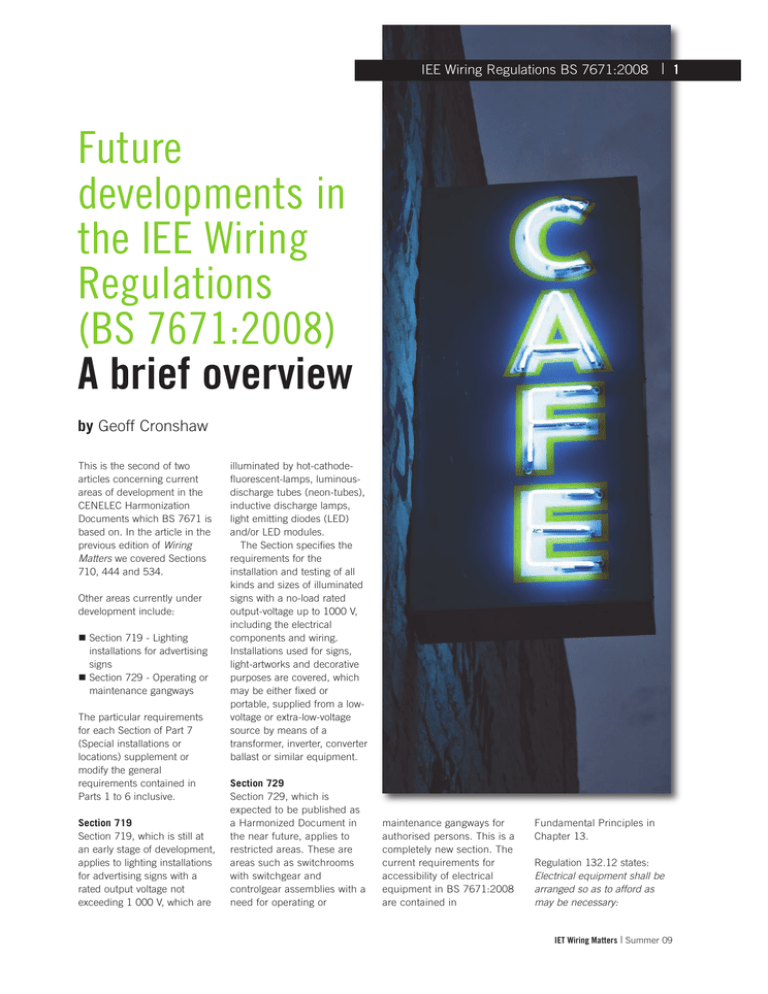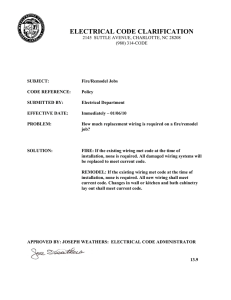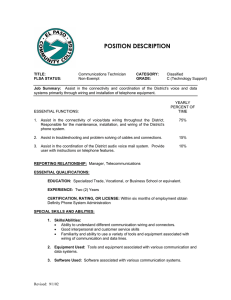
IEE Wiring Regulations BS 7671:2008 | 1
Future
developments in
the IEE Wiring
Regulations
(BS 7671:2008)
A brief overview
by Geoff Cronshaw
This is the second of two
articles concerning current
areas of development in the
CENELEC Harmonization
Documents which BS 7671 is
based on. In the article in the
previous edition of Wiring
Matters we covered Sections
710, 444 and 534.
Other areas currently under
development include:
Section 719 - Lighting
installations for advertising
signs
Section 729 - Operating or
maintenance gangways
The particular requirements
for each Section of Part 7
(Special installations or
locations) supplement or
modify the general
requirements contained in
Parts 1 to 6 inclusive.
Section 719
Section 719, which is still at
an early stage of development,
applies to lighting installations
for advertising signs with a
rated output voltage not
exceeding 1 000 V, which are
illuminated by hot-cathodefluorescent-lamps, luminousdischarge tubes (neon-tubes),
inductive discharge lamps,
light emitting diodes (LED)
and/or LED modules.
The Section specifies the
requirements for the
installation and testing of all
kinds and sizes of illuminated
signs with a no-load rated
output-voltage up to 1000 V,
including the electrical
components and wiring.
Installations used for signs,
light-artworks and decorative
purposes are covered, which
may be either fixed or
portable, supplied from a lowvoltage or extra-low-voltage
source by means of a
transformer, inverter, converter
ballast or similar equipment.
Section 729
Section 729, which is
expected to be published as
a Harmonized Document in
the near future, applies to
restricted areas. These are
areas such as switchrooms
with switchgear and
controlgear assemblies with a
need for operating or
maintenance gangways for
authorised persons. This is a
completely new section. The
current requirements for
accessibility of electrical
equipment in BS 7671:2008
are contained in
Fundamental Principles in
Chapter 13.
Regulation 132.12 states:
Electrical equipment shall be
arranged so as to afford as
may be necessary:
IET Wiring Matters | Summer 09
2 | IEE Wiring Regulations BS 7671:2008
(i) sufficient space for the
initial installation and later
replacement of individual
items of electrical equipment
(ii) accessibility for operation,
inspection, testing, fault
detection, maintenance and
repair.
Regulation 15 of the Electricity
at work Regulations has
requirements for working
space, access and lighting
and requires that, for the
purposes of enabling injury to
be prevented, adequate
working space, adequate
means of access and
adequate lighting shall be
provided at all electrical
equipment on which or near
which work is being done in
circumstances which may give
rise to danger. Regulation 14
is concerned with work on or
near any live uninsulated
conductors.
Section 719 - Lighting
installations for advertising signs
The current draft of Section
719 includes detailed
requirements relating to
lighting installations for
advertising signs. The draft at
present appears to be on the
borderline between installation
rules and product
requirements. This is possibly
because these types of
products have to be erected
and built on site. The current
draft of Section 719 includes
requirements for protection
against electric shock,
protection against thermal
effects, protection against fire,
external influences,
identification, wiring systems,
voltage drop, electrical
connections, equipment including light sources and
testing and inspection.
For example, please see below
an extract of clause 719.4 and
719.512.2:
719.41 Protection against
electric shock
719.41.A Provisions for basic
protection (protection against
direct contact)
719.41.A.2 Barriers or
enclosures
719.41.A.2.1 Additional
mechanical protection shall
consist of an enclosure or
other means of protection
conforming to the following:
a) It shall provide a degree of
protection corresponding to at
least IP 2X as specified in
EN 60529, Table 1.
NOTE 1 The requirements for
protection against ingress of solid
objects, specified in EN 60529,
Table 2, do not apply.
b) If it is constructed from
metal parts, these shall be
earthed in accordance with
clause 8, EN 50107-1.
NOTE 2 Good practice is to install a
RCD in the mains supply.
c) If it is constructed from
other materials, these shall be
materials that have been
certified by the supplier as
suitable for use in the
environment existing close to a
tube electrode, LED- modules
or any type of lamps. The
installer shall obtain from the
supplier a guarantee for the
materials covering the
expected lifetime of the
installation.
NOTE 3 Suppliers of such materials
should be informed of the temperature,
ultraviolet (UV) radiation, ozone and
other conditions existing near a tube
electrode, LED- modules or any type of
lamps. They should also be informed
that such materials might be used in
exterior situations.
d) Access to the interior of an
enclosure shall be by means of a tool,
e.g. a screwdriver.
NOTE 4 Other means of additional
protection may be permanent, e.g. it
may have to be cut away using a knife.
NOTE 5 A fully enclosed sign letter or
box sign is considered to be a suitable
enclosure for this purpose.
719.41.A.2.2
Additional requirement.
In the case of an illuminated
sign with discharge tubes, the
connections of the electrodes
shall be covered with
insulating sleeves or heat
shrinkable tubes. These
insulating sleeves or
shrinkable tubes shall be
made of a suitable insulating
material which is resistant to
the operating voltage, an
operating temperature of not
less than 180°C, UV radiation
and ozone.
NOTE 1 This requirement is intended
to prevent a person from touching a
live electrode with a test probe, should
the discharge tube be broken.
NOTE 2 Figures 1 and 2 show the
cross sections of different letter and
sign boxes.
719.512.2 External influences
719.512.2.X Drain holes
In sign enclosures intended for
external use, arrangements
shall be made to allow moisture
to drain away. Drain holes or
similar apertures used for this
purpose shall be sufficiently
large, at least 7 mm in
diameter, to ensure that they do
not get blocked with dirt or
debris between maintenance
Wiring Matters is produced by IET Services Limited, a subsidiary of The Institution of Engineering and Technology (IET), for the IET.
Michael Faraday House, Six Hills Way, Stevenage, Herts, SG1 2AY, United Kingdom Tel: +44 (0)1438 313311 Fax: +44 (0)1438 313465
Advertising Sales D Smith +44 (0)1438 767224 daniellesmith@theiet.org | Editor G D Cronshaw +44 (0)1438 767384 gcronshaw@theiet.org |
Contributing Editors M Coles, J Elliott, P Bicheno| Design Sable Media Solutions
IEE Wiring Matters is a quarterly publication from the Institution of Engineering and Technology (IET). The IET is not as a body responsible for
the opinions expressed.
©2009: The Institution of Engineering and Technology. All rights reserved. No part of this publication may be reproduced, stored in a retrieval system, or transmitted in
any form or by any means without the permission in writing of the publisher. Copying of articles is not permitted except for personal and internal use. Multiple copying of
the content of this publication without permission is always illegal. Web-offset printing by Wyndeham Heron, The Bentall Complex, Colchester Road, Heybridge, Maldon,
Essex, UK
*Postage/Handling: Postage within the UK is £3.50 for any number of titles. Outside UK (Europe) add £5.00 for first title and £2.00 for each additional book.
Rest of World add £7.50 for the first book and £2.00 for each additional book. Books will be sent via airmail. Courier rates are available on request, please call
+44 (0) 1438 767328 or email sales@theiet.org for rates.
Co-operating Organisations The Institution of Engineering & Technology acknowledges the contribution made by the following organisations in the preparation of
this publication: British Electrotechnical & Allied Manufacturers Association Ltd – P D Galbraith, M H Mullins | Department for Communities and Local Government –
I Drummond | Electrical Contractors Association – D Locke, S Burchell | City & Guilds of London Institute – H R Lovegrove | Electrical Contractors Association of Scotland
SELECT – D Millar, N McGuiness | Health & Safety Executive – K Morton | Electrical Safety Council | ERA Technology Limited – M Coates, A Finney
| Consultant - A Rufaie | Dept of Health - C Holme | British Cables Association – C Reed | Scottish Building Standards Agency | Department for Business, Enterprise
and Regulatory Reform | GAMBICA – M Hadley, A. Sedhev | Lighting Association – L Barling | ISSN 1749-978-X
IET Wiring Matters | Summer 09
PWRRFP92
IEE Wiring Regulations BS 7671:2008 | 3
visits and to maintain the
degree of protection.
As mentioned previously,
Section 719 is still at an early
stage of development in
CENELEC and will require
further work by the CENELEC
team involved before it is
published as a Harmonized
Document which is probably
two years away.
Section 729 – Operating or
maintenance gangways
The scope of this draft Section
729 applies to basic
protection and other aspects
in restricted access areas with
switchgear and controlgear
assemblies, including
requirements for operating or
maintenance gangways.
Please note the following are
draft requirements only at this
stage and should not be
worked to at present.
Where the gangway has
unprotected live parts
arranged on one side only
Clause 729.410.3.7.1 states:
Where the gangway has
unprotected live parts
arranged on one side only, the
minimum distances shall be:
a) width of gangway between
the wall and live parts
1000 mm;
b) free passage in front
of controls (handles, etc.)
700 mm;
c) height of live parts above
the floor 2 500 mm.
Where the gangway has live
parts on both sides
Clause 729.410.3.7.2 states:
Where the gangway has live
parts on both sides the
minimum distances shall be:
a) width of gangway between
live parts 1 300 mm;
b) minimum distance between
the front of the handle and the
live parts on the opposite side
of the gangway 1 100 mm;
c) minimum free passage in
front of controls (handles,
isolation position of circuitbreakers, etc.) 900 mm;
d) height of live parts above
the floor 2 500 mm.
Clause 729.513.2.3 also has
requirements for Access of
gangways.
Accessibility
Clause 729.513 requires that
the width of gangways and
access areas shall be
adequate for work, operational
access, emergency access,
emergency evacuation and for
the movement of equipment.
In restricted access areas
where the protective measure
of barriers or enclosures
applies Clause 729.513.2.1
gives the following minimum
distances:
a) width of gangways with
barriers or enclosures between
switch handles 600 mm and
circuit- breakers in position
“isolation” or switch handles
and the wall
b) width of gangway between
barriers or enclosures and
other barriers or 700 mm
enclosures, or barriers or
enclosures and the wall
c) height of panelling above
the floor 2 000 mm;
d) height of live parts above
the floor 2 500 mm.
In restricted access areas
where the protective measure
of obstacles applies Clause
729.513.2.2 gives the
following minimum distances:
a) width of gangway between
obstacles and switch handles,
or 700 mm obstacles and the
wall, or switch handles and
the wall
b) height of panelling above
the floor 2 000 mm
c) height of live parts above
the floor 2 500 mm
Annex A
Annex A contains a number of
requirements for closed
restricted access areas in
order to permit easy
evacuation. These include:
the doors of any equipment
inside the location shall
close in the direction of the
evacuation route.
Gangways shall permit
equipment doors or hinged
panels to be opened to a
minimum of 90°
For doors which can be
fixed in the open position or
circuit-breakers or
equipment which are
withdrawn fully for
maintenance (position:
completely extracted) a
minimum distance of
500 mm shall be provided
between the door edge or
circuit breaker/equipment
edge and the opposite side
of the gangway.
Minimum passing width.
Annex C
Annex C contains additional
information for closed
restricted access areas such
as requirements for
ventilation, air conditioning,
construction and lighting.
Important: The UK has a
Special national condition
relating to clause 729.410.3.7
which states:
In the UK where the gangway
has unprotected live parts
refer to UK Government
guidance on the Electricity at
Work Regulations 1989,
Statutory Instrument 1989
number 635, guidance
document HSR 25.
Therefore this UK special
national condition will take
preference over the
requirements of clause
729.410.3.7 of the
Harmonized document.
The HSE guidance
document HS(R) 25 explains
that the purpose of regulation
15 is to ensure that sufficient
space, access and adequate
illumination are provided while
persons are working on, at or
near electrical equipment in
order that they may work
safely.
HSR 25 also makes
reference to Regulation 14
which is concerned with work
on or near live conductors
which an open switchboard
would constitute.
Regulation 14 of the Electricity
at work Regulations states
that:
No person shall be engaged in
any work activity on or near
any live conductor (other than
one suitably covered with
insulating material so as to
prevent danger) that danger
may arise unless:
(a) it is unreasonable in all
circumstances for it to be
dead; and
(b) it is reasonable in all the
circumstances for him to be at
work on or near it while it is
live; and
(c) suitable precautions
(including where necessary
the provision of suitable
protective equipment) are
taken to prevent injury.
The UK National Committee
have established a Working
Group to draft Section 729 for
including in Amendment
number 1 of BS 7671:2008
and therefore the
requirements of the electricity
at work regulations and
guidance document HS(R) 25
will be taken into account.
Conclusion
A future amendment to
the IEE Wiring Regulations
(BS 7671:2008) incorporating
Section 729 is expected in
2011. IET Wiring Matters | Summer 09


